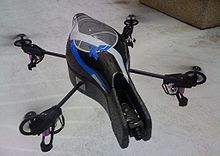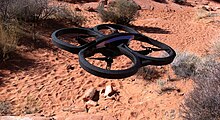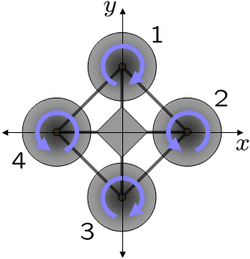Quadcopter: Difference between revisions
Spelling |
→Regulations: Removed the piece that says governments "need" to regulate quadmotors as no reason was given for why. |
||
| Line 80: | Line 80: | ||
==Regulations== |
==Regulations== |
||
As UAVs such as quadrotors become increasingly popular, the need for governments to regulate their use and possession increases. |
|||
A bill passed by Congress, and signed into law by President Barack Obama in 2012 gave the [[Federal Aviation Administration]] a deadline of September 2015 to implement regulations to permit unmanned flight.<ref>[http://www.thestar.com/news/world/2013/02/07/drones_pose_massive_challenges_for_aviation_industry.html Drone Licencing]</ref> |
A bill passed by Congress, and signed into law by President Barack Obama in 2012 gave the [[Federal Aviation Administration]] a deadline of September 2015 to implement regulations to permit unmanned flight.<ref>[http://www.thestar.com/news/world/2013/02/07/drones_pose_massive_challenges_for_aviation_industry.html Drone Licencing]</ref> |
||
Revision as of 20:57, 22 February 2013
A quadrotor, also called a quadrotor helicopter or quadcopter, is a multicopter that is lifted and propelled by four rotors. Quadrotors are classified as rotorcraft, as opposed to fixed-wing aircraft, because their lift is generated by a set of revolving narrow-chord airfoils. Unlike most helicopters, quadrotors generally use symmetrically pitched blades; these can be adjusted as a group, a property known as 'collective', but not individually based upon the blade's position in the rotor disc, which is called 'cyclic' (see helicopter). Control of vehicle motion is achieved by altering the pitch and/or rotation rate of one or more rotor discs, thereby changing its torque load and thrust/lift characteristics.
Early in the history of flight, quadrotor configurations were seen as possible solutions to some of the persistent problems in vertical flight; torque-induced control issues (as well as efficiency issues originating from the tail rotor, which generates no useful lift) can be eliminated by counter-rotation and the relatively short blades are much easier to construct. A number of manned designs appeared in the 1920s and 1930s. These vehicles were among the first successful heavier-than-air vertical take off and landing (VTOL) vehicles.[1] However, early prototypes suffered from poor performance,[1] and latter prototypes required too much pilot work load, due to poor stability augmentation[2] and limited control authority.
More recently quadrotor designs have become popular in unmanned aerial vehicle (UAV) research. These vehicles use an electronic control system and electronic sensors to stabilize the aircraft. With their small size and agile maneuverability, these quadrotors can be flown indoors as well as outdoors.[3][4]

There are several advantages to quadrocopters over comparably-scaled helicopters. First, quadrotors do not require mechanical linkages to vary the rotor blade pitch angle as they spin. This simplifies the design and maintenance of the vehicle.[5] Second, the use of four rotors allows each individual rotor to have a smaller diameter than the equivalent helicopter rotor, allowing them to possess less kinetic energy during flight. This reduces the damage caused should the rotors hit anything. For small-scale UAVs, this makes the vehicles safer for close interaction. Some small-scale quadrotors have frames that enclose the rotors, permitting flights through more challenging environments, with lower risk of damaging the vehicle or its surroundings.[6]
Due to their ease of both construction and control, quadrotor aircraft are frequently used as amateur model aircraft projects.[7][8]
History
Early Attempts
- Oehmichen No.2, 1920
Etienne Oehmichen experimented with rotorcraft designs in the 1920s. Among the six designs he tried, his helicopter No.2 had four rotors and eight propellers, all driven by a single engine. The Oehmichen No.2 used a steel-tube frame, with two-bladed rotors at the ends of the four arms. The angle of these blades could be varied by warping. Five of the propellers, spinning in the horizontal plane, stabilized the machine laterally. Another propeller was mounted at the nose for steering. The remaining pair of propellers were for forward propulsion. The aircraft exhibited a considerable degree of stability and controllability for its time, and made more than a thousand test flights during the middle 1920s. By 1923 it was able to remain airborne for several minutes at a time, and on April 14, 1924 it established the first-ever FAI distance record for helicopters of 360 m (390 yd). Later, it completed the first 1 kilometre (0.62 mi) closed-circuit flight by a rotorcraft.[9]
- de Bothezat quadrator, 1922
Dr. George de Bothezat and Ivan Jerome developed this aircraft, with six bladed rotors at the end of an X-shaped structure. Two small propellers with variable pitch were used for thrust and yaw control. The vehicle used collective pitch control. It made its first flight in October 1922. About 100 flights were made by the end of 1923. The highest it ever reached was about 5 m (16 ft 5 in). Although demonstrating feasibility, it was, underpowered, unresponsive, mechanically complex and susceptible to reliability problems. Pilot workload was too high during hover to attempt lateral motion.[10]
- Convertawings Model A Quadrotor, 1956[11]
- This unique helicopter was intended to be the prototype for a line of much larger civil and military quadrotor helicopters. The design featured two engines driving four rotors with wings added for additional lift in forward flight. No tailrotor was needed and control was obtained by varying the thrust between rotors. Flown successfully many times in the mid 1950s, this helicopter proved the quadrotor design and it was also the first four-rotor helicopter to demonstrate successful forward flight. Due to a lack of orders for commercial or military versions however, the project was terminated.
- Convertawings proposed a Model E that would have a maximum weight of 42,000 lb (19,000 kg) with a payload of 10,900 lb (4,900 kg).
- Curtiss-Wright VZ-7, 1958
- The Curtiss-Wright VZ-7 was a VTOL aircraft designed by the Curtiss-Wright company for the US Army. The VZ-7 was controlled by changing the thrust of each of the four propellers.
Recent Developments
In the last few decades, small scale Unmanned Aerial Vehicles (UAVs) have become more commonly used for many applications. The need for aircrafts with greater maneuverability and hovering ability has led to current rise in quadrotor research. The four-rotor design allows quadrotors to be relatively simple in design yet highly reliable and maneuverable. Cutting-edge research is continuing to increase the viability of quadrotors by making advances in multi-craft communication, environment exploration, and maneuverability. If all of these developing qualities can be combined together, quadrotors would be capable of advanced autonomous missions that are currently not possible with any other vehicle.[12]
Some current programs include:
- The Bell Boeing Quad TiltRotor concept takes the fixed quadrotor concept further by combining it with the tilt rotor concept for a proposed C-130 sized military transport.


- Aermatica Spa's Anteos is the first rotary wing RPA (remotely piloted aircraft) to have obtained official permission to fly (Permit To Fly) issued in the civil airspace, by the Italian Civil Aviation Authority (ENAC), and will be the first able to work in non segregated airspace.[13]
- AeroQuad is an open-source hardware and software project which utilises Arduino boards and freely provides hardware designs and software for the DIY construction of Quadrocopters.[14]
- ArduCopter is an open-source multicopter UAV. Based on Arduino, it supports from four to eight motors, as well as traditional helicopters, and allows fully autonomous missions as well as RC control. [15]
- OpenPilot is a model aircraft open-source software project.[citation needed]
- Parrot AR.Drone is a small radio controlled quadrocopter with cameras attached to it built by Parrot SA, designed to be controllable with iOS or Android devices. Parrot AR.Drone 2.0 carries a HD 720P camera and more sensors, such as altimeter and magnetometer.[16]
Uses
Research Platform
Quadrotors are a useful tool for university researchers to test and evaluate new ideas in a number of different fields, including Flight control theory, Navigation, Real time systems, and robotics. In recent years many universities have shown quadrotors performing increasingly complex aerial manoeuvres. Swarms of quadrotors can hover in mid-air, in formation, autonomously perform complex flying routines such as flips, darting through hula-hoops and organise themselves to fly through windows as a group.[17][18]
There are numerous advantages for using quadrotors as versatile test platforms. They are relatively cheap, available in a variety of sizes and their simple mechanical design means that they can be built and maintained by amateurs. Due to the multi-disciplinary nature of operating a quadrotor, academics from a number of fields need to work together In order to make significant improvements to the way quadrotors perform. Quadrotor projects are typically collaborations between computer science, electrical engineering and mechanical engineering specialists.[17]
Because they are so manoeuvrable, quadrotors could be useful in all kinds of situations and environments. Quadrotors capable of autonomous flight could help remove the need for people to put themselves in any number of dangerous positions. This is a prime reason that research interest has been increasing of the years.[17]
There are some world-class engineering research laboratories currently developing more advanced control techniques and applications for quadrotors. These include mainly MIT's Aerospace Controls Lab[19], ETH's Flying Machine Arena[20], and University of Pennsylvania's General Robotics, Automation, Sensing and Perception (GRASP) Lab.[21]
Military
Militaries around the world use Unmanned combat air vehicle for routine surveillance and to carry out basic attack strategies.
Quadrotors are currently used in the real world for surveillance and reconnaissance by law enforcement agencies and the military as well as search and rescue missions in urban environments.[22] One such example is the Aeryon Scout, created by Canadian company Aeryon Labs,[23] is a small UAV that can quietly hover in place and point its powerful camera to people and objects on the ground. The company claims that the machine has played a key role in a drug bust in Central America by providing visual surveillance of a narco-trafficker's compound deep in the jungle (Aeryon won't reveal the country's name and other specifics). [24]
Commercial
The largest use of quadrotors has been in the field of aerial imagery. Quadrotor UAVs are suitable for this job because of their autonomous nature and huge cost savings.[12] Capturing aerial imagery with a quadrotor is as simple as programming GPS coordinates and hitting the go button. Using on-board cameras, users have the option of being streamed live to the ground. Many companies have used this for real estate photography to industrial systems inspection. Various organizations are taking advantage of the quadrotor’s closed-circuit television capabilities and ability to provide an eye in the sky to the action below.[25]
Design Features
Mechanical
The main mechanical components needed for construction are the frame, propellers (either fixed-pitch or variable-pitch), and the electric motors. For best performance and simplest control algorithms, the motors and propellers should be placed with the same distance between them as shown in the these figures.[26] Various materials can be used for all parts. Recently, carbon fiber composites have become popular due to their light weight and structural stiffness.[27]
Electrical
The electrical components needed to construct a working quadrotor are similar to those needed for a modern RC helicopter. They are the Electronic Speed Control module, on-board computer or controller board, and battery. Typically, a hobby remote control is also used to allow for human input.[28]
Flight control

Each rotor produces both a thrust and torque about its center of rotation, as well as a drag force opposite to the vehicle's direction of flight. If all rotors are spinning at the same angular velocity, with rotors one and three rotating clockwise and rotors two and four counterclockwise, the net aerodynamic torque, and hence the angular acceleration about the yaw axis is exactly zero, which implies that the yaw stabilizing rotor of conventional helicopters is not needed. Yaw is induced by mismatching the balance in aerodynamic torques (i.e., by offsetting the cumulative thrust commands between the counter-rotating blade pairs).[29]
Flight Characteristics
Angular accelerations about the pitch and roll axes can be caused separately without affecting the yaw axis. Each pair of blades rotating in the same direction controls one axis, either roll or pitch, and increasing thrust for one rotor while decreasing thrust for the other will maintain the torque balance needed for yaw stability and induce a net torque about the roll or pitch axes. This way, fixed rotor blades can be made to maneuver the quad rotor vehicle in all dimensions. Translational acceleration is achieved by maintaining a non-zero pitch or roll angle.
Regulations
A bill passed by Congress, and signed into law by President Barack Obama in 2012 gave the Federal Aviation Administration a deadline of September 2015 to implement regulations to permit unmanned flight.[30]
Recently, the FAA has achieved the first unmanned aircraft systems milestone included in the 2012 FAA reauthorization – streamlining the process for public agencies to safely fly UAS in the nation's airspace.[31]
See also
References
- ^ a b Leishman, J.G. (2000). Principles of Helicopter Aerodynamics. New York, NY: Cambridge University Press.
- ^ Anderson, S.B. (March). "Historical Overview of V/STOL Aircraft Technology" (PDF). NASA Technical Memorandum 81280.
{{cite journal}}: Check date values in:|date=and|year=/|date=mismatch (help) - ^ Hoffmann, G.M. (November 2004). "The Stanford Testbed of Autonomous Rotorcraft for Multi Agent Control (STARMAC)" (PDF). In the Proceedings of the 23rd Digital Avionics System Conference. Salt Lake City, UT. pp. 12.E.4/1-10.
{{cite conference}}: Unknown parameter|booktitle=ignored (|book-title=suggested) (help); Unknown parameter|coauthors=ignored (|author=suggested) (help) - ^ Büchi, Roland (2011). Fascination Quadrocopter. ISBN 978-3-8423-6731-9.
{{cite book}}: CS1 maint: location (link) CS1 maint: location missing publisher (link) - ^ Pounds, P. (December 2006). "Modelling and Control of a Quad-Rotor Robot" (PDF). In the Proceedings of the Australasian Conference on Robotics and Automation. Auckland, New Zealand.
{{cite conference}}: Unknown parameter|booktitle=ignored (|book-title=suggested) (help); Unknown parameter|coauthors=ignored (|author=suggested) (help) - ^ Hoffman, G. (20–23 August 2007). "Quadrotor Helicopter Flight Dynamics and Control: Theory and Experiment" (PDF). In the Conference of the American Institute of Aeronautics and Astronautics. Hilton Head, South Carolina.
{{cite conference}}: Unknown parameter|booktitle=ignored (|book-title=suggested) (help); Unknown parameter|coauthors=ignored (|author=suggested) (help) - ^ Arduino-based quadcopter
- ^ UAVP-NG based quadcopter
- ^ "Oemichen helicopter - development history, photos, technical data".
- ^ "De Bothezat - development history, photos, technical data".
- ^ "Helicopters of the World" Flight 2 November 1956 p722]
- ^ a b Coming of Age of Quadrotors
- ^ "Products". Aermatica. Retrieved 2012-05-30.
- ^ Davies, Chris (13 January 2010). "DIY Quadrocopters: Quaduino NG and AeroQuad [Videos]". SlashGear. Retrieved 4 February 2012.
- ^ "ArduCopter 3D Robotics Quadcopter". Retrieved May 24, 2012.
- ^ Parrot AR.Dreon 2.0 Specifications
- ^ a b c What Makes Quadrotors so Popular
- ^ UPenn Quadrotor Research
- ^ Aerospace Controls Lab at MIT
- ^ The Flying Machine Arena
- ^ UPenn GRASP Advanced Laboratory
- ^ Military Quadrotors
- ^ Aeryon Labs Company
- ^ Spying Aerial Robots for the Law Enforcement
- ^ Microdrones Company
- ^ Typical Quadrotor Mechanical Design Aspects
- ^ Using Composite Material for Quadrotors
- ^ Basic Assembly Kit for a Quadrotor
- ^ Basic Flight Control Laws for Quadrotors
- ^ Drone Licencing
- ^ Unmanned Aircraft Systems in the FAA
